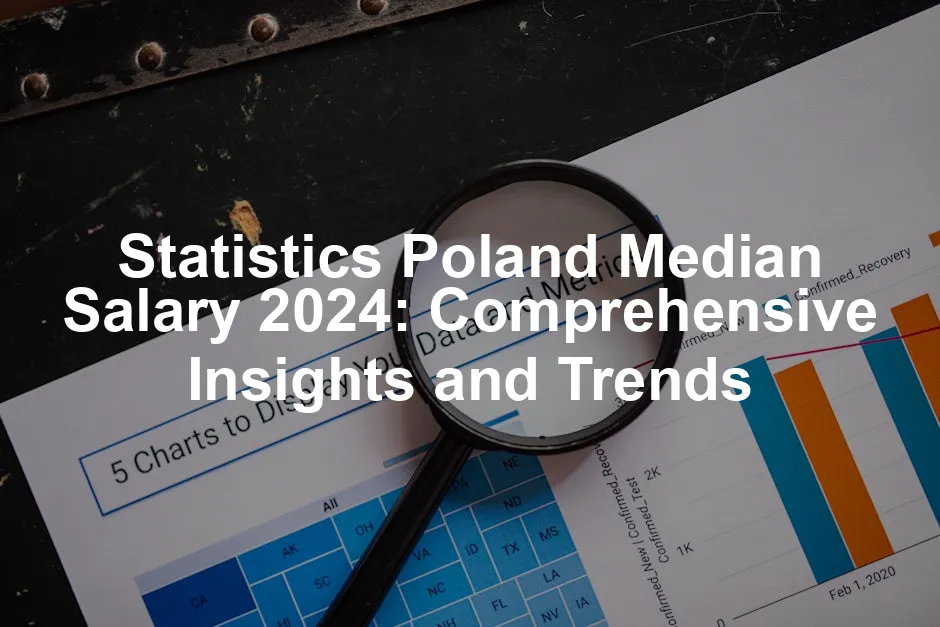Introduction
As Poland strides into 2024, its economic landscape is buzzing with activity. The country has seen a steady growth trajectory, with GDP growth rates outpacing many of its EU counterparts. This growth has been fuelled by a booming technology sector, robust manufacturing, and an increasing foreign investment appetite. As businesses expand, understanding salary statistics becomes crucial for job seekers, employers, and policymakers alike.
Why should everyone care about salary figures? For job seekers, salary data can dictate which roles they pursue and how they negotiate pay. Employers, on the other hand, need to stay competitive to attract top talent. Lastly, policymakers rely on these statistics to inform economic strategies and support sustainable growth.
When it comes to salaries in Poland, three key metrics stand out: average, median, and minimum salaries. While the average salary can be skewed by a handful of high earners, the median salary provides a clearer picture of the typical wage. It serves as a more stable indicator of income distribution, helping to illustrate economic health.
In 2024, the median salary is projected to be around 6,540 PLN per month, a number that reflects a more accurate representation of what most workers earn. Understanding this figure is essential for anyone navigating the Polish labor market, as it can impact everything from budgeting to lifestyle choices.

Speaking of budgeting, why not take control of your finances with a classic read? Check out “The Richest Man in Babylon” by George S. Clason. This timeless classic provides essential financial wisdom through engaging parables. It’s a must-read for anyone wanting to understand the basics of wealth building!
For a deeper understanding of the importance of median salaries in the context of Poland’s economic landscape, check out this insightful article on statistics Poland median salary 2024.
Understanding Salaries in Poland
What is the Median Salary?
The median salary is the midpoint of all salaries within a specific group, meaning that half of the population earns more and half earns less. This statistic is particularly relevant in economic data as it minimizes the impact of outliers—those high or low salaries that can distort averages.
Imagine a classroom where the average score is skewed by a few students acing the exam while others barely pass. The median, however, reveals how most students are performing. In Poland, the median salary is an invaluable tool for gauging the economic well-being of the workforce.
Comparing median and average salaries helps illustrate the economic landscape. The average salary in Poland is approximately 7,590 PLN, a figure that is noticeably higher than the median. This discrepancy indicates that a small number of high earners are pulling the average up, while the majority earn closer to the median. Thus, while both metrics are important, the median salary provides a more stable view of the income distribution.
In summary, understanding the nuances between the average and median salaries is vital for anyone involved in the Polish labor market. It sheds light on the economic realities faced by the typical worker, helping to shape informed decisions for job seekers, employers, and policymakers alike.

To further enhance your financial literacy, consider reading “Thinking, Fast and Slow” by Daniel Kahneman. This book dives into the dual systems of thought that shape our decisions, helping you understand your own financial behaviors better.
Current Salary Statistics
As we look ahead to 2024, the median salary in Poland is projected at 6,540 PLN per month. This figure is crucial as it represents a more accurate midpoint of incomes, providing clarity on what most workers earn. In comparison, the average salary stands at 7,590 PLN. This slight difference highlights the impact of high earners on the average, pulling it up while most employees earn closer to the median.
The minimum wage in Poland is set at 4,300 PLN per month. This amount ensures that workers receive a basic level of income, aligning with national efforts to improve living standards.
When examining salary differences through the lens of gender, a noteworthy gender pay gap persists. On average, men earn about 8% more than women. Specifically, the average salary for men is approximately 8,000 PLN, while women earn around 7,350 PLN. This disparity, though lower than the EU average, signals the ongoing need for equality in the workplace.

If you’re looking to manage your finances better, why not invest in your health as well? The Fitbit Charge 5 Health and Fitness Tracker can help you keep track of your well-being, ensuring that you’re not just financially fit but physically fit too!
Analysis of Salary Trends in 2024
Year-on-Year Changes
The wage landscape in Poland has changed significantly over the past few years. In 2024, the average salary rose by an impressive 14.7% compared to 2023. This substantial increase can be attributed to various factors, including government policies aimed at boosting wages, inflation rates, and a thriving economy.
Key elements driving wage growth include the recent adjustments to the minimum wage, which directly affects salaries across the board. The Polish government increased the minimum wage to 4,300 PLN per month, reflecting a commitment to improving worker compensation. This move has a ripple effect on average salaries, encouraging employers to raise pay to attract and retain talent.
Inflation also plays a significant role in salary adjustments. In recent times, Poland has faced rising living costs, prompting many companies to reassess their wage structures. As inflation rates fluctuate, businesses find themselves compelled to offer higher salaries to maintain employee satisfaction and purchasing power.
Overall, these factors contribute to a robust wage growth trend in Poland for 2024. As the economy continues to evolve, it’s essential for both employees and employers to stay informed about these shifts in the labor market.

Salary Distribution Across Industries
Poland’s job market showcases a colorful spectrum of salaries across various sectors. Let’s break it down!
Information Technology (IT) reigns supreme with median salaries ranging from 8,000 to 12,000 PLN. This sector attracts tech-savvy professionals, all eager to join the coding carnival. As the digital landscape expands, demand for IT talent surges, making it a lucrative field.
In contrast, the healthcare sector offers interesting figures, with median salaries typically around 8,500 PLN. Nurses, doctors, and specialists work tirelessly, often in high-pressure environments. While rewarding, the pay often reflects the demanding nature of the job.
The education sector doesn’t fare as well, with average salaries hovering around 5,500 PLN for teachers. While shaping young minds is priceless, the financial rewards aren’t quite as exciting. This disparity highlights the need for better compensation for educators, who are essential to society.

Speaking of shaping young minds, consider grabbing a copy of “The Millionaire Next Door”. This book explores the habits of wealthy individuals and can help anyone understand the principles of wealth accumulation.
Manufacturing jobs yield median salaries of approximately 6,000 PLN. This sector remains the backbone of Poland’s economy, providing jobs to countless workers. Though less glamorous than tech, manufacturing plays a crucial role in the nation’s growth.
What about retail? Salaries there can dip as low as 4,000 PLN. Retail workers often juggle long hours and demanding customers for modest pay. It’s a tough gig, showing the need for better support and remuneration in this vital sector.
Industry Insights
Diving deeper, the IT sector continues to shine, with salaries reflecting the skills and knowledge required. Developers and data analysts are riding the wave, with earnings often exceeding 12,000 PLN. It’s clear that if you have the right tech skills, your wallet will thank you.
On the other hand, agriculture and hospitality present lower average salaries, typically around 4,500 to 5,500 PLN. While these sectors are essential to everyday life, they often struggle with wage growth. However, there’s potential for growth. As consumer demand for local produce and quality service rises, so too can salaries in these fields.
In summary, the salary landscape in Poland is diverse and sometimes surprising. Understanding these nuances helps job seekers navigate their options and can drive change in industries that need it most. The disparities serve as a reminder that while some sectors flourish, others may need a little extra love to keep up with the times.

If you’re looking to boost your culinary skills while you’re at it, consider investing in an Ninja Foodi 9-in-1 Pressure Cooker. It’s perfect for quick meals that fit any budget!
Examples of Average Salaries in Major Cities
Salaries in Poland vary significantly by region. Understanding these differences is essential for job seekers and employers alike. Here’s a snapshot of average salaries in key cities:
- Warsaw: The capital leads with an average salary of 8,550 PLN. As a financial and tech hub, it attracts high-skilled professionals. Just beware of the rent prices that might have you wondering if you can afford the view!
- Kraków: This charming city averages around 8,320 PLN. Known for its historical significance and vibrant cultural scene, it’s a magnet for startups and creative industries. Who doesn’t want to work where history meets innovation?
- Wrocław: With an average salary of 8,090 PLN, Wrocław is gaining traction. The city is becoming a hotspot for IT and business services. Plus, its picturesque architecture makes the daily commute a bit more enjoyable.
- Gdańsk: This coastal gem offers an average salary of 6,920 PLN. The city’s economy thrives on shipbuilding and tourism. Just imagine working while enjoying the sea breeze!
- Lublin: Rounding out the list, Lublin has an average salary of 6,510 PLN. While it may not be the highest, the lower cost of living makes it an appealing choice for many. Sometimes, it’s not about how much you earn but how far it goes!

To enjoy your time in any of these cities, consider investing in a good pair of headphones! The Sony WH-1000XM4 Wireless Headphones will ensure you enjoy your favorite tunes while commuting!
The Impact of Economic Factors on Salary
Inflation and Cost of Living
In 2024, inflation remains a pivotal factor influencing salary growth in Poland. With rising prices, purchasing power is under pressure. If you thought your paycheck was stretching thin before, inflation is like that friend who always borrows your favorite sweater and never gives it back.
As the cost of living continues to increase, many employees find themselves negotiating salaries more aggressively. Employers need to keep up! If wages don’t reflect the higher living costs, employees could feel like they’re running a marathon but only getting a participation trophy.

To help ease those financial burdens, consider a Anker PowerCore Portable Charger. It’s perfect for keeping your devices charged on the go, so you can always stay connected!
Employment Trends
Employment growth rates paint an optimistic picture for job seekers. As sectors like IT and finance expand, opportunities abound. However, the job market is not without its challenges. Unemployment rates have seen fluctuations, currently sitting at 5%. While this isn’t alarming, it does highlight the competition for roles.
High unemployment can exert downward pressure on salaries. If more people are vying for fewer positions, companies may offer less. The key takeaway? Keep your skills sharp! In a competitive landscape, those who invest in their growth stand to gain the most. Plus, who doesn’t love the thrill of landing a job? It’s like winning the lottery, but without the confetti and champagne.
In summary, the economic factors shaping salaries in Poland are multifaceted. Inflation impacts purchasing power, while employment trends dictate opportunities. Staying informed can help job seekers navigate this dynamic landscape. With the right skills and knowledge, you can turn potential challenges into exciting career opportunities!

Future Salary Predictions
Economic Forecasting for 2025 and Beyond
The future of salaries in Poland looks promising as we approach 2025. Experts predict steady growth in median wages, driven by multiple factors. One of the primary influences is the ongoing economic expansion, making Poland an attractive destination for foreign investments. With the government’s focus on boosting wages, we can expect to see a steady increase in the median salary, which is projected to rise above the current 6,540 PLN per month.
Inflation remains a concern, but its impact on salaries is nuanced. While inflation can erode purchasing power, it often prompts employers to adjust salaries upwards to maintain employee satisfaction. As inflation rates stabilize, the pressure to increase wages may ease slightly, allowing companies to offer competitive salaries without compromising their bottom line.
Government policies also play a crucial role in shaping salary trends. Recent legislative changes have set the minimum wage at 4,300 PLN, which has a ripple effect across various sectors. As companies align their pay structures with minimum wage requirements, we can expect median salaries to rise accordingly. Additionally, sectors experiencing rapid growth, like IT and finance, are likely to see even higher salary increases, reflecting the demand for skilled workers.
Moreover, global market conditions will influence salary dynamics. With economic uncertainties persisting worldwide, Poland’s ability to attract foreign investment will depend on its competitiveness. As businesses navigate these challenges, they may offer better salaries to retain talent, particularly in high-demand sectors.
In summary, the next few years may witness a gradual wage increase in Poland, influenced by economic growth, government policies, and global market conditions. For job seekers and employers, understanding these trends is essential for making informed decisions in the evolving labor market.

Conclusion
In conclusion, the median salary in Poland for 2024 stands at approximately 6,540 PLN per month, reflecting a significant rise driven by various economic factors. The average salary, currently around 7,590 PLN, highlights disparities influenced by high earners skewing the average. Understanding these figures is crucial for job seekers, employers, and policymakers alike.
For job seekers, knowing the median salary aids in setting realistic salary expectations and negotiating better compensation. Employers, on the other hand, need to stay competitive in attracting top talent, especially as inflation and the cost of living continue to rise. Policymakers can leverage this data to shape economic strategies that promote wage growth while ensuring economic stability.
It’s essential for all stakeholders to continuously monitor salary trends as economic conditions evolve. With the Polish economy on an upward trajectory, keeping an eye on these statistics will provide valuable insights into the labor market’s future. By staying informed, both employees and employers can navigate the complexities of wage expectations, ultimately contributing to a healthier economic environment.

If you’re looking to further your knowledge on personal finance, consider reading “The Total Money Makeover” by Dave Ramsey. His step-by-step plan can help you get your finances in order!
FAQs
What is the median salary in Poland for 2024?
The median salary is approximately 6,540 PLN per month.
How does the median salary compare to the average salary?
The average salary is around 7,590 PLN, indicating a slight difference due to high earners affecting the average.
What factors influence salaries in Poland?
Factors include industry, regional economic conditions, inflation, and employment rates.
How often are salary statistics updated?
Salary statistics are updated quarterly by Statistics Poland.
What are the implications of salary statistics for job seekers?
Understanding salary trends helps job seekers negotiate better compensation and choose suitable job opportunities.
Please let us know what you think about our content by leaving a comment down below!
Thank you for reading till here 🙂
All images from Pexels




